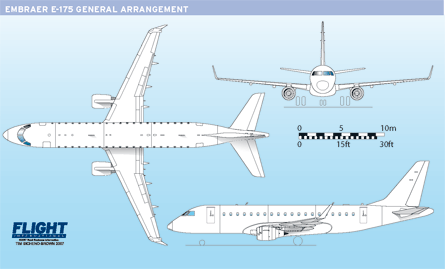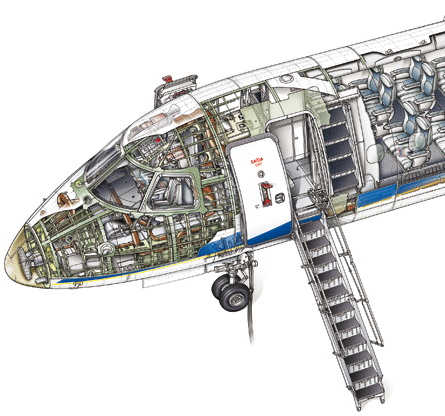The last - but by no means least - member of Embraer's E-Jet family, the E-175, is carving out a niche in the regional jet market after a tough start
As with the other elements of Embraer's ambitious but cleverly crafted E-Jet strategy, the E-175, the last member, is finally establishing its long-expected niche in the resurgent large regional jet and small airliner markets.
Designed to scour the outermost edges of the scope-clause envelope in the US regional market, as well as exploit the growing trend for "right-sizing" in Europe and elsewhere, the 78- to 88-seat E-175 was at one stage in danger of becoming the right jet at the wrong time. Uncertainty over the orderbook meant it had the toughest time of all the E-Jet siblings in gaining its initial foothold, and in early 2004 Embraer was forced to take the difficult decision to delay or "re-optimise" the certification and delivery schedule.
Embraer officially unveiled plans for the E-175 variant at the roll-out of the E-170 in October 2001, with deliveries due to start in July 2004. Although India's Jet Airways announced a deal for up to 20 E-175s in July 2002, these orders lapsed and first deliveries were eventually made to Air Canada, which became the launch customer with orders and options for up to 30 aircraft.
| |
|---|
The E-175 enjoys the same envelope protection as its siblings thanks to Honeywell's fly-by-wire flight control systems |
The first of these were delivered in July 2005, marking roughly a year-long lag in the schedule originally foreseen by what was by then a much-relieved Embraer. Since then the little airliner has slowly but surely opened up a growing orderbook, with firm orders standing at 99 and options at 136 by early 2007. Deliveries were meanwhile heading towards the 30 mark.
In June 2003 at the Paris air show Embraer was able to score a mini-news coup by announcing the start of E-175 flight tests. By February 2004 the two aircraft involved in the 250h test programme had accumulated a combined total of around 100h. However, the good news on testing was tempered by the lack of firm orders, a situation that prompted the then senior vice-president engineering and new product development Luis Carlos Affonso to declare that "certification was scheduled for mid-2004, but we've decided to re-optimise the campaign due to changes in market conditions and we've pushed it back to the fourth quarter".
However, despite the customer issues, Embraer ploughed ahead with the test and certification programme and clearance from Brazilian civil aviation authority ANAC was granted in December 2004, just 11 months after its E-170 sibling. European Aviation Safety Agency certification was won in January 2005, while US Federal Aviation Administration approval was granted in August 2006. The first aircraft (No 0014) was used to test handling qualities and for performance evaluation tests. The second, No 0017, was used for flutter, buffet, systems and interior testing. Other than minor systems and handling checks resulting from the slight stretch, the flight test and certification effort was comparably short and heavily based on that of the E-170.

Confidence rewarded
The company's confidence in the basic credibility of its mini-stretch of the E-170 was rewarded when Air Canada became the launch customer for the E-175 in November 2004 with 15 firm orders plus 15 options for the 73-seat jet. The firm orders, valued at $420 million with a potential value of $840 million with options, was a major vote of confidence in the variant and sparked a flurry of interest from other North American carriers, which continues to this day.
"Air Canada has shown foresight in looking to smaller airliners as a key component of its future success, and we are happy to be a part of its strategy," said outgoing Embraer president and chief executive Mauricio Botelho, who saw the deal as the final vindication of the company's E-Jet strategy. "Like other airlines with an eye on the future, Air Canada will reap the benefits of a new family of aircraft specifically designed for the market niche between 70 and 110 seats," commented Botelho at the time.
Air Canada opted for a two-class configuration with nine seats in "Executive" class with three-abreast seating offering 39in (99cm) pitch, and 64 seats in "Hospitality" with four-abreast seating offering 32in pitch. Yet with a fuselage 1.78m longer than that of the E-170, the E-175 offers room for 86 seats, or 10% more seating and cargo capacity. However, it shares a common pilot type rating, a common cockpit, identical flying qualities with its fly-by-wire system, and a common engine, the General Electric CF34-8E.
With an overall length of 31.6m versus 29.9m for the E-170, the E-175 stretch is accomplished with two plugs forward and aft of the wing. The forward plug, measuring 84cm, adds a seat row to the front of the Latécoère-built centre fuselage section I, and is visible as a sixth window position forward of the engine inlet line. The aft plug is a 94cm-long section added to the Embraer, Sonaca and Akros-built centre fuselage section II, which adds a further seat row and window aft of the wing trailing edge. The Embraer-built forward fuselage and cockpit section, and the Latécoère centre-fuselage section III remain unchanged, as do the Aernnova (Spain)-built rear fuselage, empennage and Hamilton Sundstrand tailcone section and auxiliary power unit.
Pressure bulkhead
The rear fuselage incorporates the same dome-shaped pressure bulkhead fabricated from a forged and rolled ring with 10 radial sections as found in the other family members. The aft section also contains a cutout for the horizontal stabiliser, which remains unchanged from the E-170 with a 10m span. The vertical tail, originally 9.85m on the E-170, is reduced to 9.73m. Lessons learned during the E-170 flight tests also led to an increase of the E-190/195 stabiliser and fin dimensions. The aftmost frame consists of two separate upper and lower "D" shapes joined by duplicated stabiliser hinge fittings.
The fuselage shares the hallmark cross-section, which Affonso, now senior vice-president Embraer executive jets, describes as "one of the most innovative aspects of the design". Affonso, who oversaw the E-Jet development, says the decision to adopt the four-abreast layout was driven by the need to avoid the middle seat of a five-abreast layout. The resulting cross-section "has nothing to do with smaller jets. We wanted to get the same seat width and overhead bins that you would find on the big jets," he says.
The cross-section, which comprises a double-bubble made up of two circular arcs of different radii, provides a 2.74m-wide cabin with up to 2m interior headroom and a 0.94m- deep underfloor hold below the main deck. Although more structurally complicated than the purely circular cross-section adopted by some of its competitors, Embraer says the market response justifies the design. In the E-175 the total storage volume, including cargo compartments, overhead bins, underseat stowage and wardrobes, is over 25.5m3 (900ft3), against 22.6m3 for the E-175.
Shared span
The E-175 shares the same 26m span as the E-170, which compares with the 28.72m span of the E-190/195. The wing is set with a dihedral of 5 degrees and has an aspect ratio of 9.2 without the winglets. Modestly sweptback at the 25% chord point at just under 23.5 degrees, the wing is made in two main parts an inner wing-stub and an outer wing section. Wing sections are supplied by Embraer as well as Kawasaki Heavy Industries of Japan and Sonaca of Belgium.
In terms of systems, the E-170 and E-175 share 100% commonality between line replaceable units (LRU), as well as 86% commonality with the larger E-190/195 siblings. The few differences to be found are mostly concerned with increases in lengths of cabling, wiring or ducts. The autoflight control system, is identical between the two but for the length of the wiring harness from the main bus to the rest of the system in the flightdeck area. Similarly, the flight-control system has slightly longer aileron command cables than the E-170. The E-175 is not, however, certificated for the steep approach mode (SAM) primarily developed to enable the E-170 to operate into London City airport.
The SAM mode is enabled with a pushbutton switch on the centre pedestal just ahead of the speed brake handle, and could be adapted for the slightly stretched variant. The SAM allows spoiler panels 4 and 5 to move in and out in response to pilot inputs to alter the flightpath to fly the nominal 5.5 degrees approach to London City. The E-170 fly-by-wire system senses the neutral position of the control column and adjusts spoiler deflection accordingly.
Some minor changes are also found in the aircraft's air management system, again mostly due to simple geometry changes. Embraer says "two requirements are updated to the E-175, which are the number of occupants and fuselage stretch, affecting heat transfer area and pressurised volume. The E-170 is sized with margin to cover the changes." The flexible ducting in the air conditioning distribution system, for example, is increased by 84cm in the centre fuselage Section I, while the crew oxygen system has an added pipe and additional pair of brackets. The APU bleed tubing, potable water tank pressurisation line and air conditioning distribution ducts were also stretched in the aft section.
The architecture otherwise remains unchanged for the engine and wing anti-ice and overall air conditioning systems. Other modifications include the re-routing to the forward area of the resized water tank pressurisation line, and the addition of an overhead detector sensor in the bleed system. The pre-cooler, which is installed inside the nacelle of the CF34-8EA1/5 versions of the engine available on the E-175, is identical to that of the E-170.
The landing-gear system remains identical, despite the slight change in fuselage length, with all operational characteristics and indicating systems the same. The only differences are found in the emergency/parking brake and free-fall systems, which are fitted with longer cables. Although the hydraulic system remains identical in terms of LRUs and overall operation, the installations are slightly altered due to the length changes. System 1, 2 and 3 lines are all stretched by around 94cm, while system 2 has an additional 84cm to accommodate the forward fuselage stretch. Similarly the fuel systems are identical but for a 91cm stretch of the APU feed line.
In early March 2007 the E-175 finally made its US domestic debut, with the delivery of the first aircraft to Republic Airlines. The company has orders for 30 E-175s, which will be operated in an 86-seat layout under the US Airways Express brand. Republic already operates 76 E-170s, and will be followed by new Northwest carrier Compass, which plans to start E-175 operations between July and September. By the end of the year, Compass expects to fly 10 E-175s on services to Northwest's three hubs, including Detroit Metro airport. With all four members of the E-170/190 family now in service, it appears that Embraer's E-Jet dream is about to be realised.
Source: Flight International




















